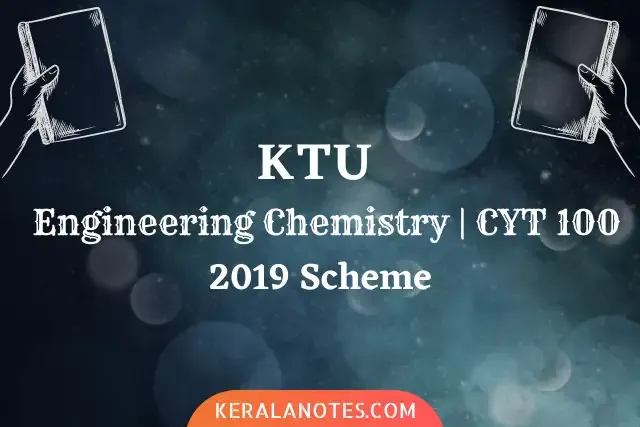Engineering Chemistry (CYT100) introduces students to the knowledge of chemical concepts for engineering applications, introduce KTU students to various application centre topics such as spectroscopy, Electrochemistry, Instrumentation techniques, and introduce them to topics such as corrosion mechanisms, corrosion prevention techniques, SEM, stereochemistry Get it done polymers, desalination, etc., which help to develop skills and competencies related to chemical research and practice.
| Board | KTU |
| Scheme | 2019 New Scheme |
| Year | First Year |
| Semester | S1 & S2 |
| Subject | CYT 100 | ENGINEERING CHEMISTRY |
| Credit | 4 Credit |
| Category | KTU S1 & S2 |
KTU S1/S2 Engineering Chemistry | CYT 100 | Notes (2019 Scheme)
Module 1
Module 1 - Syllabus
Electrochemistry and Corrosion
Introduction - Differences between electrolytic and electrochemical cells - Daniel cell - redox reactions - cell representation. Different types of electrodes (brief) - Reference electrodes - SHE - Calomel electrode - Glass Electrode - Construction and Working. Single electrode potential - definition - Helmholtz electrical double layer -Determination of E 0 using calomel electrode.Determination of pH using a glass electrode.Electrochemical series and its applications. Free energy and EMF - Nernst Equation - Derivation - single electrode and cell (Numericals) -Application - Variation of emf with temperature. Potentiometric titration - Introduction -Redox titration only.Lithium-ion cell - construction and working.Conductivity- Measurement of conductivity of a solution (Numericals).
Corrosion-Electrochemicalcorrosion – mechanism. Galvanic series- cathodic protection - electroless plating –Copper and Nickel plating.
Module 1 - Notes
Module 1 Engineering chemistry | CYT 100 PDF Notes
Module 2
Module 2 - Syllabus
Spectroscopic Techniques and Applications
Introduction- Types of the spectrum - electromagnetic spectrum - molecular energy levels - Beer Lambert’s law (Numericals). UV-Visible Spectroscopy – Principle - Types of electronic transition Energy level diagram of ethane, butadiene, benzene and hexatriene. Instrumentation of UV-Visible spectrometer and applications.IR-Spectroscopy – Principle - Number of vibrational modes - Vibrational energy states of a diatomic molecule and -Determination of force constant of diatomic 1 molecule (Numericals) –Applications. H NMR spectroscopy – Principle - Relation between field strength and frequency - chemical shift - spin-spin splitting (spectral problems ) - coupling constant (definition) - applications of NMR- including MRI (brief).
Module 2 - Notes
Module 2 Engineering chemistry | CYT 100 PDF Notes
Module 3
Module 3 - Syllabus
Instrumental Methods and Nanomaterials
Thermal analysis –TGA- Principle, instrumentation (block diagram) and applications – TGA of CaC 2 O 4 . H 2 O and polymers. DTA-Principle, instrumentation (block diagram) and applications - DTA of CaC 2 O 4 . H 2 O. Chromatographic methods - Basic principles and applications of column and TLC- Retention factor. GC and HPLC-Principle, instrumentation (block diagram) - retention time and applications. Nanomaterials - Definition - Classification - Chemical methods of preparation - Hydrolysis and Reduction - Applications of nanomaterials - Surface characterisation -SEM – Principle and instrumentation (block diagram).
Module 3 - Notes
Module 3 Engineering chemistry | CYT 100 PDF Notes
Module 4
Module 4 - Syllabus
Stereochemistry and Polymer Chemistry
Isomerism-Structural, chain, position, functional, tautomerism and matamerism - Definition with examples - Representation of 3D structures-Newman, Sawhorse, Wedge and Fischer projection of substituted methane and ethane. Stereoisomerism - Geometrical isomerism in double bonds and cycloalkanes (cis-trans and E-Z notations). R-S Notation – Rules and examples - Optical isomerism, Chirality, Enantiomers and Diastereoisomers-Definition with examples.Conformational analysis of ethane, butane, cyclohexane, mono and di methyl substituted cyclohexane.
Copolymers - Definition - Types - Random, Alternating, Block and Graft copolymers - ABS - preparation, properties and applications.Kevlar-preparation, properties and applications.Conducting polymers - Doping -Polyaniline and Polypyrrole - preparation properties and applications. OLED - Principle, construction and advantages.
Module 4 - Notes
Module 4 Engineering chemistry | CYT 100 PDF Notes
Module 5
Module 5 - Syllabus
Water Chemistry and Sewage Water Treatment
Water characteristics - Hardness - Types of hardness- Temporary and Permanent - Disadvantages of hard water -Units of hardness- ppm and mg/L -Degree of hardness (Numericals) - Estimationhardness-EDTA method (Numericals). Water softening methods-Ion exchange process-Principle procedure and advantages. Reverse osmosis – principle, process and advantages. Municipal waste treatment (brief) - Disinfection methods - chlorination, ozone and UV irradiation.
Dissolved oxygen (DO) -Estimation (only brief procedure-Winkler’s method), BOD and COD- definition, estimation (only brief procedure) and significance (Numericals). Sewage water treatment - Primary, Secondary and Tertiary - Flow diagram -Trickling filter and UASB process.
Module 5 - Notes
Module 5 Engineering chemistry | CYT 100 PDF Notes
KTU S1 & S2 Related Links
| KTU S1 & S2 Study Materials | Click Here |
| KTU S1 & S2 Study Notes | Click Here |
| KTU S1 & S2 Syllabus | Click Here |
| KTU S1 & S2 Reference Textbook | Click Here |
| KTU S1 & S2 Previous Year Solved Question Papers | Click Here |
Other Related Links
| PHT 100 - Engineering Physics A | Click Here |
| PHT 110 - Engineering Physics B | Click Here |
| MAT 101 - Linear Algebra and Calculus | Click Here |
| EST 100 - Engineering Mechanics | Click Here |
| EST 120 - Basics of Civil Engineering | Click Here |
| EST 120 - Basics of Mechanical Engineering | Click Here |
| HUT 101 - Life Skills | Click Here |
| CYT 100 - Engineering Chemistry | Click Here |
| EST 110 - Engineering Graphics | Click Here |
| MAT 102 - Vector Calculus, Differential Equations and Transforms | Click Here |
| EST 102 - Programming in C | Click Here |
| EST 130 - Basics of Electrical Engineering | Click Here |
| EST 130 - Basics of Electronics Engineering | Click Here |
| HUT 102 - Professional Communication | Click Here |






